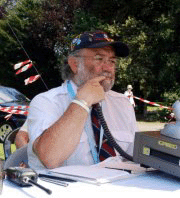Home Location: IO93PR.
Base Station Rigs: Yaesu FTdx10. TenTec Argonaut 535.
QRP Working : FTdx10 or TenTec Argonaut 535. Max power normally used: 5 watts or 2 watts output.
Station antennas: Now using a long wire for inter G type QSO's. An original Cobweb at 11mtrs and a 2 mtr / 70 cmsCollinear at 12 mtrs.
ATU : LDG AT-200 Pro Autotuner. ETM-4c Electronic Keyer.
Mobile working : ICOM 2820, Magmount Collinear. IC-92D/IC51E and DV-MEGA Hotspot.
Portable working : Icom 706 mk 2G. Portable Inverted V Doublet, ladder feeder
or an Outbacker Outreach antenna.
A potted history of you know who......
Whilst serving in the RAF during the 1960's as a Special Operator
Telegraphist, stationed at RAF Butzweilerhof near Cologne, at RAF
Gatow, Berlin and at two stations in England; I had the pleasure of
being introduced to Amateur Radio by Colin Tomas (G3PSM) who was heavily
involved with the RSGB. A couple of years later in early 1974, I decided
to expand and continue my interest in Amateur Radio by taking the
City & Guilds and after receiving a pass, took the morse test
at the Liverpool Merchant Marine Radio Training Centre and passed;
thankfully due I am sure to RAF operations and experience. Thereafter
I applied for an amateur licence and was allocated the call sign of
G4DQP.
For many years I only worked QRP CW with a nominal 2 watts output using the heathkit 7 & 8 both of which I built.
Various antennas were tried in the early days with the conclusion
that under normal conditions the best 'multi band' antenna was the
Doublet fed with open wire feeders via an atu. Yes there were and
are better single band antennas with more gain, but as an 'all rounder',
the Doublet as an inverted V always came out tops so far as I was
concerned. A vertical tri bander was used for a couple of years which
was better for DX over the 3,000 mile skip distance, but of recent
times I have always gone back to the old favourite of the inverted
V Doublet. More recently I bought a Cobweb Kit from G3TPW fitted it atop of an 11 mtr pole, complete with guy ropes. The first time I switched over to the cobweb I thought it was faulty as there did not appear to be any noise. Does it work, my word it does, VP8 station with only 75 watts, it's brilliant.
Of more recent times I had to take down the Inverted Doublet, and reverted to the (1930's) by putting up a short (Long Wire), primarily to reduce noise from the houses. I have started to peep into the 20th
centuary by trying out the likes of PSK and FT8 via the radio laptop used for logging; very
different from the mandatory 2 watts cw that I concider to be my 'proper'
every day radio mode.
I decided to go back to my roots so to speak, by rejoining and getting
involved again with the Royal Air Force Amateur Radio Society, originally
being a member in the late 1970's; and after rejoining became a member
of the RAFARS Field Day Team as well as the organiser for the RAFARS
'Airfields On The Air' (AOTA) event. I decided that I may have something
to offer others and became a civilian instructor for the ATC with
1324 Sqn for Radio (what else is there!). A number of years I was very active with the East Yorkshire RAYNET Group, going out
with the group on mainly horse riding and walking events over 9 months
of each year; and also being the group's secretary from February 2006
until October 2009 and from May 2012 becoming the controller untill
October 2013.
In November 2013 I was privalaged
to become an officer of RAFARS Council taking the position of General
Secretary after changes to the makeup of the Council resigning early 2022 due to health concerns.
I have been fortunate to obtain an NoV on my own call sign that allows me to use the
special event call sign G4RAF which is a RAFARS club callsign but in my name. Ofcom did allow me an NoV for 5 mhz
operations under the experimental arrangements made with the RSGB, but now as standard.
Also we need to remember the ATC Cadets are having an exercises called 'Blue Ham' in conjunction with amateurs, on 60 mtrs (5 Mhz) band and also hopefully further Blue Ham excercise will continue in the year. When ATC Cadet stations are on the air, we do need to encourage these young people into amateur radio. So if you hear a station give them a call.
On looking back at my radio life, I think
it is such a shame that I do not have the 100 foot high, tuned Rombics
to play with now, as I had in my service days!!!...such a shame....if
only,....now the best I can do is a Cobweb Beam to the higher bands.
Alas it is nearly sixty years since I joine the RAF, so even if the brain says I am able; the body does not want or allow me to climb up roofs etc. So it looks like it is going to be on the operating position from now on.

